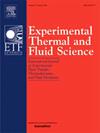NACA 63(4)-421翼型吸力侧后缘狭缝气动性能分析
IF 3.3
2区 工程技术
Q2 ENGINEERING, MECHANICAL
Experimental Thermal and Fluid Science
Pub Date : 2025-09-04
DOI:10.1016/j.expthermflusci.2025.111604
引用次数: 0
摘要
目前的工作解决了在低雷诺数条件下由层流分离气泡引起的空气动力学惩罚,这在无人机和小型风力涡轮机中很普遍。该狭槽设计已经过实验验证,为提高此类关键应用中的气动效率提供了一种被动、经济的解决方案。因此,本研究通过力测量实验(FMEs)和表面油流可视化(SOFV)技术在吸力型风洞中对NACA 63(4)-421翼型在吸力侧加装后缘槽(TES)的气动性能进行了研究。为了提高流动再附着和气动效率,TES狭缝几何设计考虑了以下参数:狭缝宽度比、狭缝角度、狭缝进口位置、康达半径(rc)、狭缝出口吸力侧半径(rt)和狭缝进口压力侧半径(rp)。在0°至30°范围内测试的四种TES配置中;模型2 (M2)在研究的攻角(AoA)范围内表现出优越的性能。M2失速角比基线(B1)延迟3°,达到17°,最大升力系数(CL,max)达到1.51,比基线(B1)增加122%。与失速前区域的B1相比,M2模型显著减少了通过从槽几何形状喷射而产生的不希望的波动升力。在6°~ 16°AoAs处,高动量槽流与主流有效相互作用,使边界层重新充能,增强了表面附着。这种机制直接有助于延迟失速。此外,具有TES的NACA 63(4)-421翼型已被证明可以重新激活边界层,修改层流分离线(LSL)和湍流再附着线(TRL)的位置,并扩大湍流区域。这反过来又通过控制层膜分离气泡(LSB)来增强表面流动附着并延迟失速。优化后的狭缝几何形状和有效的流动相互作用相结合,证实了TES配置显著提高了9x104 Re的气动性能。本文章由计算机程序翻译,如有差异,请以英文原文为准。
Aerodynamic performance analysis of a NACA 63(4)-421 airfoil equipped with a trailing edge slot at suction side
The present work addresses the aerodynamic penalties caused by laminar separation bubbles in low Reynolds number regimes, which are prevalent in UAVs and small wind turbines. The slot design, which has been subjected to experimental validation, offers a passive, cost-effective solution for enhancing aerodynamic efficiency in such critical applications. Therefore, this study investigates the aerodynamic performance of the NACA 63(4)-421 airfoil equipped with a Trailing Edge Slot (TES) at suction side, evaluated through Force Measurement Experiments (FMEs) and Surface Oil Flow Visualization (SOFV) techniques in suction type wind tunnel. To improve flow reattachment and aerodynamic efficiency, the TES slot geometry was designed taking into account the following parameters: slot width ratio, slot angle, slot inlet location, and Coanda radius (rc), slot outlet suction side radius (rt), and slot inlet pressure side radius (rp). Among the four TES configurations tested in the 0° to 30° range; Model 2 (M2) demonstrated superior performance across the investigated angle of attack (AoA) range. The stall angle of M2 was delayed by 3°, reaching 17° compared to the baseline (B1), and the maximum lift coefficient (CL,max) reached 1.51, corresponding to a 122% increase compared to B1. M2 model significantly reduces the undesired fluctuating lift via jet injection from the slot geometry as compared to the B1 at pre-stall region. At AoAs between 6° and 16°, the high-momentum slot flow effectively interacted with the main flow, re-energizing the boundary layer and enhancing surface attachment. This mechanism directly contributes to delaying the stall. Furthermore, NACA 63(4)-421 airfoil having TES has been demonstrated to re-energise the boundary layer, modify the position of the Laminar Separation Line (LSL), and Turbulent Reattachment Line (TRL) and expand the turbulent flow region. This, in turn, has been shown to enhance surface flow attachment and delay stall by controlling the laminer separation bubble (LSB). The combination of optimized slot geometry and effective flow interaction confirms that TES configurations significantly enhance aerodynamic performance in Re of 9x104.
求助全文
通过发布文献求助,成功后即可免费获取论文全文。
去求助
来源期刊

Experimental Thermal and Fluid Science
工程技术-工程:机械
CiteScore
6.70
自引率
3.10%
发文量
159
审稿时长
34 days
期刊介绍:
Experimental Thermal and Fluid Science provides a forum for research emphasizing experimental work that enhances fundamental understanding of heat transfer, thermodynamics, and fluid mechanics. In addition to the principal areas of research, the journal covers research results in related fields, including combined heat and mass transfer, flows with phase transition, micro- and nano-scale systems, multiphase flow, combustion, radiative transfer, porous media, cryogenics, turbulence, and novel experimental techniques.
 求助内容:
求助内容: 应助结果提醒方式:
应助结果提醒方式:


